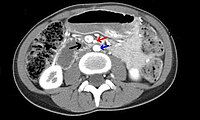
Photo from wikipedia
Purpose Intracranial carotid artery occlusion represents an underinvestigated cause of acute ischemic stroke as well as an indication for mechanical thrombectomy. We investigated baseline and procedural characteristics, outcomes and predictors… Click to show full abstract
Purpose Intracranial carotid artery occlusion represents an underinvestigated cause of acute ischemic stroke as well as an indication for mechanical thrombectomy. We investigated baseline and procedural characteristics, outcomes and predictors of outcome in patients with acute ischemic stroke secondary to intracranial carotid artery occlusion. Methods A retrospective analysis of the Italian Registry of Endovascular Treatment in Acute Stroke was performed. Patients with intracranial carotid artery occlusion (infraclinoid and supraclinoid) with or without cervical artery occlusion but with patent intracranial arteries were included. The 3‑month functional independence, mortality, successful reperfusion and symptomatic intracranial hemorrhage were evaluated. Results Intracranial carotid artery occlusion with patent intracranial arteries was diagnosed in 387 out of 4940 (7.8%) patients. The median age was 74 years and median baseline National Institute of Health Stroke Scale (NIHSS) was 18. Functional independence was achieved in 130 (34%) patients, successful reperfusion in 289 (75%) and symptomatic intracranial hemorrhage in 33 (9%), whereas mortality occurred in 111 (29%) patients. In univariate analysis functional independence was associated with lower age, lower NIHSS at presentation, higher rate of successful reperfusion and lower rate of symptomatic intracranial hemorrhage. Multivariable regression analysis found age (odds ratio, OR:1.03; P = 0.006), NIHSS at presentation (OR: 1.07; P < 0.001), diabetes (OR: 2.60; P = 0.002), successful reperfusion (OR:0.20; P < 0.001) and symptomatic intracranial hemorrhage (OR: 4.17; P < 0.001) as the best independent predictors of outcome. Conclusion Our study showed a not negligible rate of intracranial carotid artery occlusion with patent intracranial arteries, presenting mostly as severe stroke, with an acceptable rate of 3‑month functional independence. Age, NIHSS at presentation and successful reperfusion were the best independent predictors of outcome.
Journal Title: Clinical Neuroradiology
Year Published: 2020
Link to full text (if available)
Share on Social Media: Sign Up to like & get
recommendations!